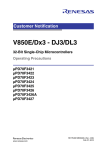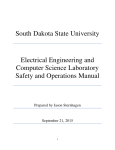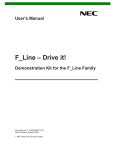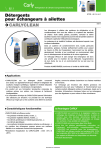Download V850ES/SG3, V850ES/SJ3
Transcript
Customer Notification
V850ES/SG3, V850ES/SJ3
32-bit Single-Chip Microcontrollers
Operating Precautions
µPD70F3333, µPD70F3334, µPD70F3335,
µPD70F3336, µPD70F3340, µPD70F3341,
µPD70F3342, µPD70F3343, µPD70F3344,
µPD70F3345, µPD70F3346, µPD70F3347,
µPD70F3348, µPD70F3350, µPD70F3351,
µPD70F3352, µPD70F3353, µPD70F3354,
µPD70F3355, µPD70F3356, µPD70F3357,
µPD70F3358, µPD70F3364, µPD70F3365,
µPD70F3366, µPD70F3367, µPD70F3368
Document No. U18391EE2V0IF00
Date Published March 2007
© NEC Electronics (Europe) GmbH
DISCLAIMER
The related documents in this customer notification may include preliminary versions. However, preliminary
versions may not have been marked as such.
The information in this customer notification is current as of its date of publication. The information is subject
to change without notice. For actual design-in, refer to the latest publications of NEC’s data sheets or data
books, etc., for the most up-to-date specifications of NEC PRODUCT(S). Not all PRODUCT(S) and/or types
are available in every country. Please check with an NEC sales representative for availability and additional
information.
No part of this customer notification may be copied or reproduced in any form or by any means without prior
written consent of NEC. NEC assumes no responsibility for any errors that may appear in this customer
notification. NEC does not assume any liability for infringement of patents, copyrights or other intellectual
property rights of third parties by or arising from the use of NEC PRODUCT(S) listed in this customer
notification or any other liability arising from the use of such PRODUCT(S).
No license, express, implied or otherwise, is granted under any patents, copyrights or other intellectual
property rights of NEC or others. Descriptions of circuits, software and other related information in this
customer notification are provided for illustrative purposes of PRODUCT(S) operation and/or application
examples only. The incorporation of these circuits, software and information in the design of customer’s
equipment shall be done under the full responsibility of customer. NEC assumes no responsibility for any
losses incurred by customers or third parties arising from the use of these circuits, software and information.
While wherever feasible, NEC endeavors to enhance the quality, reliability and safe operation of
PRODUCT(S) the customer agree and acknowledge that the possibility of defects and/or erroneous thereof
cannot be eliminated entirely. To minimize risks of damage to property or injury (including death) to persons
arising from defects and/or errors in PRODUCT(S) the customer must incorporate sufficient safety measures
in their design, such as redundancy, fire-containment and anti-failure features.
The customer agrees to indemnify NEC against and hold NEC harmless from any and all consequences of
any and all claims, suits, actions or demands asserted against NEC made by a third party for damages
caused by one or more of the items listed in the enclosed table of content of this customer notification for
PRODUCT(S) supplied after the date of publication.
Applicable Law:
The law of the Federal Republic of Germany applies to all information provided by NEC to the Customer under
this Operating Precaution document without the possibility of recourse to the Conflicts Law or the law of 5th
July 1989 relating to the UN Convention on Contracts for the International Sale of Goods (the Vienna CISG
agreement).
Düsseldorf is the court of jurisdiction for all legal disputes arising directly or indirectly from this information.
NEC is also entitled to make a claim against the Customer at his general court of jurisdiction.
If the supplied goods/information are subject to German, European and/or North American export controls,
the Customer shall comply with the relevant export control regulations in the event that the goods are
exported and/or re-exported. If deliveries are exported without payment of duty at the request of the
Customer, the Customer accepts liability for any subsequent customs administration claims with respect to
NEC.
Notes: 1. “NEC” as used in this statement means NEC Electronics Corporation and also includes its direct
or indirect owned or controlled subsidiaries.
2. “PRODUCT(S)” means ‘NEC semiconductor products’ (NEC semiconductor products means any
semiconductor product developed or manufactured by or for NEC) and/or ‘TOOLS’ (TOOLS
means ‘hardware and/or software development tools’ for NEC semiconductor products’
developed, manufactured and supplied by ‘NEC’ and/or ‘hardware and/or software development
tools’ supplied by NEC but developed and/or manufactured by independent 3rd Party vendors
worldwide as their own product or on contract from NEC)
2
Customer Notification U18391EE2V0IF00
Operating Precautions for V850ES/SG3, V850ES/SJ3
(A)
Table of Operating Precautions . . . . . . . . . . . . . . . . . . . . . . . . . . . . . . . . . . . . . . . . 5
(B)
Description of Operating Precautions. . . . . . . . . . . . . . . . . . . . . . . . . . . . . . . . . . 16
(C)
Valid Specification . . . . . . . . . . . . . . . . . . . . . . . . . . . . . . . . . . . . . . . . . . . . . . . . . 23
(D)
Revision History . . . . . . . . . . . . . . . . . . . . . . . . . . . . . . . . . . . . . . . . . . . . . . . . . . . 24
Customer Notification U18391EE2V0IF00
3
Operating Precautions for V850ES/SG3, V850ES/SJ3TM
4
Customer Notification U18391EE2V0IF00
Operating Precautions for V850ES/SG3, V850ES/SJ3
(A) Table of Operating Precautions
µPD70F3333,
µPD70F3335
Rev.
No.
✓:
✗:
RankNote
Outline
1.0
1.1
I
I
1
Setting of DTFR register
(Specification change notice)
✗
✗
2
TMP and TMQ Capture Operation
(Specification change notice)
✗
✗
3
Flash security flag setting
(Technical limitation)
✗
✓
4
Boot swap function of selfprogramming
(Technical limitation)
✗
✓
5
AFCAN: Sleep Mode Wakeup
(Specification change notice)
✗
✗
Not applicable
Applicable
Note: The rank is indicated by the letter appearing at the 5th position from the left in the lot number, marked
on each product.
Customer Notification U18391EE2V0IF00
5
Operating Precautions for V850ES/SG3, V850ES/SJ3TM
µPD70F3334,
µPD70F3336
Rev.
No.
✓:
✗:
RankNote
Outline
1.0
1.1
I
I
1
Setting of DTFR register
(Specification change notice)
✗
✗
2
TMP and TMQ Capture Operation
(Specification change notice)
✗
✗
3
Flash security flag setting
(Technical limitation)
✗
✓
4
Boot swap function of selfprogramming
(Technical limitation)
✗
✓
5
AFCAN: Sleep Mode Wakeup
(Specification change notice)
✗
✗
Not applicable
Applicable
Note: The rank is indicated by the letter appearing at the 5th position from the left in the lot number, marked
on each product.
6
Customer Notification U18391EE2V0IF00
Operating Precautions for V850ES/SG3, V850ES/SJ3
µPD70F3340,
µPD70F3350
Rev.
No.
RankNote
Outline
1.0
1.1
I
I
1
Setting of DTFR register
(Specification change notice)
✗
✗
2
TMP and TMQ Capture Operation
(Specification change notice)
✗
✗
3
Flash security flag setting
(Technical limitation)
✗
✓
4
Boot swap function of selfprogramming
(Technical limitation)
✗
✓
5
AFCAN: Sleep Mode Wakeup
(Specification change notice)
✗
✗
✓ : Not applicable
✗:
Applicable
Note: The rank is indicated by the letter appearing at the 5th position from the left in the lot number, marked
on each product.
Customer Notification U18391EE2V0IF00
7
Operating Precautions for V850ES/SG3, V850ES/SJ3TM
µPD70F3341,
µPD70F3351
Rev.
No.
RankNote
Outline
1.0
I
1
Setting of DTFR register
(Specification change notice)
✗
2
TMP and TMQ Capture Operation
(Specification change notice)
✗
3
Flash security flag setting
(Technical limitation)
✓
4
Boot swap function of selfprogramming
(Technical limitation)
✓
5
AFCAN: Sleep Mode Wakeup
(Specification change notice)
✗
✓ : Not applicable
✗:
Applicable
Note: The rank is indicated by the letter appearing at the 5th position from the left in the lot number, marked
on each product.
8
Customer Notification U18391EE2V0IF00
Operating Precautions for V850ES/SG3, V850ES/SJ3
µPD70F3342,
µPD70F3352
Rev.
No.
RankNote
Outline
1.0
I
1
Setting of DTFR register
(Specification change notice)
✗
2
TMP and TMQ Capture Operation
(Specification change notice)
✗
3
Flash security flag setting
(Technical limitation)
✓
4
Boot swap function of selfprogramming
(Technical limitation)
✓
5
AFCAN: Sleep Mode Wakeup
(Specification change notice)
✗
✓ : Not applicable
✗:
Applicable
Note: The rank is indicated by the letter appearing at the 5th position from the left in the lot number, marked
on each product.
Customer Notification U18391EE2V0IF00
9
Operating Precautions for V850ES/SG3, V850ES/SJ3TM
µPD70F3343,
µPD70F3353
Rev.
No.
RankNote
Outline
1.0
I
1
Setting of DTFR register
(Specification change notice)
✗
2
TMP and TMQ Capture Operation
(Specification change notice)
✗
3
Flash security flag setting
(Technical limitation)
✓
4
Boot swap function of selfprogramming
(Technical limitation)
✓
5
AFCAN: Sleep Mode Wakeup
(Specification change notice)
✗
✓ : Not applicable
✗:
Applicable
Note: The rank is indicated by the letter appearing at the 5th position from the left in the lot number, marked
on each product.
10
Customer Notification U18391EE2V0IF00
Operating Precautions for V850ES/SG3, V850ES/SJ3
µPD70F3344,
µPD70F3354,
µPD70F3364
Rev.
No.
RankNote
Outline
1.0
1.1
I
I
1
Setting of DTFR register
(Specification change notice)
✗
✗
2
TMP and TMQ Capture Operation
(Specification change notice)
✗
✗
3
Flash security flag setting
(Technical limitation)
✗
✓
4
Boot swap function of selfprogramming
(Technical limitation)
✗
✓
5
AFCAN: Sleep Mode Wakeup
(Specification change notice)
✗
✗
✓ : Not applicable
✗:
Applicable
Note: The rank is indicated by the letter appearing at the 5th position from the left in the lot number, marked
on each product.
Customer Notification U18391EE2V0IF00
11
Operating Precautions for V850ES/SG3, V850ES/SJ3TM
µPD70F3345,
µPD70F3355,
µPD70F3365
Rev.
No.
RankNote
Outline
1.0
1.1
I
I
1
Setting of DTFR register
(Specification change notice)
✗
✗
2
TMP and TMQ Capture Operation
(Specification change notice)
✗
✗
3
Flash security flag setting
(Technical limitation)
✗
✓
4
Boot swap function of selfprogramming
(Technical limitation)
✗
✓
5
AFCAN: Sleep Mode Wakeup
(Specification change notice)
✗
✗
✓ : Not applicable
✗:
Applicable
Note: The rank is indicated by the letter appearing at the 5th position from the left in the lot number, marked
on each product.
12
Customer Notification U18391EE2V0IF00
Operating Precautions for V850ES/SG3, V850ES/SJ3
µPD70F3346,
µPD70F3356,
µPD70F3366
Rev.
No.
RankNote
Outline
1.0
1.1
I
I
1
Setting of DTFR register
(Specification change notice)
✗
✗
2
TMP and TMQ Capture Operation
(Specification change notice)
✗
✗
3
Flash security flag setting
(Technical limitation)
✗
✓
4
Boot swap function of selfprogramming
(Technical limitation)
✗
✓
5
AFCAN: Sleep Mode Wakeup
(Specification change notice)
✗
✗
✓ : Not applicable
✗:
Applicable
Note: The rank is indicated by the letter appearing at the 5th position from the left in the lot number, marked
on each product.
Customer Notification U18391EE2V0IF00
13
Operating Precautions for V850ES/SG3, V850ES/SJ3TM
µPD70F3347,
µPD70F3357,
µPD70F3367
Rev.
No.
RankNote
Outline
1.0
1.1
I
I
1
Setting of DTFR register
(Specification change notice)
✗
✗
2
TMP and TMQ Capture Operation
(Specification change notice)
✗
✗
3
Flash security flag setting
(Technical limitation)
✗
✓
4
Boot swap function of selfprogramming
(Technical limitation)
✗
✓
5
AFCAN: Sleep Mode Wakeup
(Specification change notice)
✗
✗
✓ : Not applicable
✗:
Applicable
Note: The rank is indicated by the letter appearing at the 5th position from the left in the lot number, marked
on each product.
14
Customer Notification U18391EE2V0IF00
Operating Precautions for V850ES/SG3, V850ES/SJ3
µPD70F3348,
µPD70F3358,
µPD70F3368
Rev.
No.
RankNote
Outline
1.0
1.1
I
I
1
Setting of DTFR register
(Specification change notice)
✗
✗
2
TMP and TMQ Capture Operation
(Specification change notice)
✗
✗
3
Flash security flag setting
(Technical limitation)
✗
✓
4
Boot swap function of selfprogramming
(Technical limitation)
✗
✓
5
AFCAN: Sleep Mode Wakeup
(Specification change notice)
✗
✗
✓ : Not applicable
✗:
Applicable
Note: The rank is indicated by the letter appearing at the 5th position from the left in the lot number, marked
on each product.
Customer Notification U18391EE2V0IF00
15
Operating Precautions for V850ES/SG3, V850ES/SJ3TM
(B) Description of Operating Precautions
No. 1
Setting of DTFR register
(Specification change notice)
Details
When the DTFR register is written a DMA request may occur.
When rewriting the IFCn5...IFCn0 flags of the DTFR register, the following bit may be set:
a) DFn bit of the same register in which IFCn5...IFCn0 are set.
b) DFm bit of a DMA channel with a lower priority than that of the DMA channel for which
IFCn5...IFCn0 are set but only if IFCn5...IFCn0 are equal to IFCm5...IFCm0.
Workaround
1.) Stop the DMA transmission of DMA channels that apply to the above description.
2.) Check if the DFn(m) bit corresponding to the above description is “0” after rewriting
IFCn5...IFCn0.
No. 2
TMP and TMQ Capture Operation
(Specification change notice)
Details
When the input capture function is selected for Timer P or Timer Q and a clock of fxx/8 or slower
is selected as the count clock for this timer the following applies:
When a capture signal is input during the first count clock after TPnCE=1 for Timer P (TQnCE=1
for Timer Q resprectively) the capture operation is not executed and the corresponding capture
interrupt is not issued.
Workaround
There is no workaround.
No. 3
Flash security flag setting
(Technical limitation)
Details
It may not be possible to use or clear the security flag of the flash memory.
Workaround
There is no workaround. Do not use the security flag setting function in the flash programmer.
16
Customer Notification U18391EE2V0IF00
Operating Precautions for V850ES/SG3, V850ES/SJ3
No. 4
Boot swap function of selfprogramming
(Technical limitation)
Details
It may not be possible to use the boot swap function in selfprogramming mode.
Workaround
There is no workaround. Do not use the boot swap function.
Customer Notification U18391EE2V0IF00
17
Operating Precautions for V850ES/SG3, V850ES/SJ3TM
No. 5
AFCAN: Sleep Mode Wakeup
(Specification change notice)
Details:
1. Exclusions
This Operating Precaution is only applicable to applications, which are fulfilling at least one of
the following three conditions:
• SLEEP Mode of AFCAN is used and the possibility to wake up AFCAN by CAN-Bus
events is given (see Remarks: 1.)
• During SLEEP mode of the AFCAN macro, a CAN-Bus wakeup condition occurs, while
the AFCAN macro is supplied with clock (see Remarks: 2.) and
- after waking up from SLEEP mode of the AFCAN macro, the application software does
not wait until the SLEEP mode is released by polling the CnCTRL (PSMODE) register,
before continuing operation with the AFCAN macro (see Remarks: 3.) and
- the CPU can reach instructions, where AFCAN registers are accessed while the
AFCAN macro is still in SLEEP mode, due to the missing waiting condition.
• During SLEEP mode of the AFCAN macro, a CAN-Bus wakeup condition occurs, while
the AFCAN macro is supplied with clock (see Remarks: 2.) and
- after waking up from SLEEP mode of the AFCAN macro, the CAN Bus Transceiver
generates a long-lasting or permanent dominant level to the CRXD input of the
AFCAN macro, instead of the propagated CAN-Bus level.
Remarks: 1. If the CAN-Bus Transceiver does not propagate the CAN-Bus signal, while the
AFCAN macro is in SLEEP mode, and also does not forward a wakeup signal to
CRXD, this Operating Precaution is not applicable.
2. The clock supply to the AFCAN macro can be stopped, depending on the features
of the device, and the system design of the application. If the clock supply to the
AFCAN macro is stopped, while a wakeup condition occurs, this Operating Precaution is not applicable.
3. The maximum waiting time for this loop can be up to 10 bits of the CAN-Bus
Baudrate.
Waiting while retrying to clear CnINTS (Bit 5) can be used alternatively.
All other applications are not affected by this Operating Precaution.
2. Description
When the AFCAN macro is set into SLEEP mode, it can be woken up by CAN bus activity.
This waking up is asynchronous to the operation of the macro and the CPU. By configuration setting, a WAKEUP interrupt can be generated by the AFCAN macro on the wakeup event.
While the interrupt is generated asynchronously, the AFCAN macro may need another dominant
edge on the CAN bus, or software clearing of the SLEEP mode, in order to restart its synchronous
operation.
During the time, after the interrupt already has been indicated, and before the CAN macro has
restarted its synchronous operation, the registers of the AFCAN macro will not operate, because
the AFCAN macro still remains in SLEEP mode. This time we will refer to as “wakeup dead time”
in the following context.
18
Customer Notification U18391EE2V0IF00
Operating Precautions for V850ES/SG3, V850ES/SJ3
No. 5
AFCAN: Sleep Mode Wakeup
(Specification change notice)
To resolve from the wakeup dead time, software and/or hardware measures are required.
Note: However, this Precaution does not apply to all applications. Only dedicated applications
are affected (see above).
3. Application Dependency
3.1 Overview
The following flowchart illustrates, how and whether additional measures have to be taken in software, to avoid the wakeup dead time.
AFCAN sleep mode
(In case AFCAN Clock is disabled)
Releasing AFCAN sleep mode
by CAN bus activity
Releasing AFCAN sleep mode
by user
After detected dominant edge
PSMODE0 = 0
CINTS5 = 1
(In case AFCAN Clock is active)
Releasing AFCAN sleep mode
by CAN bus activity
After detected dominant edge
PSMODE0 = 0/1
CINTS5 = 1
Clear PSMODE0 bit:
Additional Measure
Clear PSMODE0 bit
Clear CINTS5 bit
Clear CINTS5 bit
END
Figure 3-1: Additional Measures in case AFCAN clock is active when waking up
3.2 Not affected Applications
3.2.1 Applications not using SLEEP mode
If SLEEP mode is not used, this Operating Precaution is not applicable.
3.2.2 Applications waking up from SLEEP mode by User Request only
If there is no condition, when SLEEP mode can be left by CAN-Bus activity, but only on User
Request (by clearing the PSMODE flag by software), this Operating Precaution is not applicable.
Customer Notification U18391EE2V0IF00
19
Operating Precautions for V850ES/SG3, V850ES/SJ3TM
No. 5
AFCAN: Sleep Mode Wakeup
(Specification change notice)
3.2.3 Applications using a CPU Power Save Mode
If the clock to the AFCAN macro is disabled, while it is woken up from SLEEP mode, this Operating Precaution is not applicable.
This means, if the user selects a power save mode of the target device, which switches off the
clock of the AFCAN macro, immediately after it had been set into SLEEP mode, like the “CPU
STOP” mode, the precaution needs not to be considered.
This is associated with the software improvement hints below.
3.3 Affected Applications
3.3.1 Applications not waiting until SLEEP mode is left
If Bus Transceivers are used in conjunction with AFCAN, which will propagate the CAN-Bus signal to AFCAN permanently (not switched off or not in power saving modes), or, if Bus Transceivers are used in conjunction with AFCAN, which will propagate the unmodified CAN-Bus signal
when waking up from a power save mode, the wakeup dead time lasts from the first recessive-todominant edge of the CAN-Bus signal, which generates the wake-up, until the next recessive-todominant edge of the CAN-Bus signal.
The worst case (maximum length) of the wakeup dead time, is given by the CAN bus speed and
the rule of the CAN bus about the frequency of recessive-to-dominant edges. Given by the stuffing rule, at least every 10 bits, a recessive-to-dominant edge must occur.
If during the wakeup dead time, the CPU waits until the SLEEP mode is indicated to be cleared
(either by polling the PSMODE flag, or by retrying to clear CnINTS[5]), this Operating Precaution is not applicable. In this case, the Improvement Hint according to 4.2.2 is followed
implicitly.
If during the wakeup dead time, the CPU does not perform any access to the AFCAN macro in
any case, this Operating Precaution is not applicable.
3.3.2 Applications using Bus Transceivers generating long-lasting dominant CAN-Bus Signals
If Bus Transceivers are used in conjunction with AFCAN, which generate a permanent or longlasting dominant level when waking up from a power save mode, the Operating Precaution must
be considered in any case.
In this case, the wakeup dead time lasts from the first recessive-to-dominant edge of the CANBus signal, which generates the wake-up, until the next recessive-to-dominant edge of the CANBus signal, depending on the behaviour of the CAN-Bus Transceiver.
If no further dominant edge on the CAN bus occurs (in case of some CAN Transceivers, which
only provide one single edge on waking up), the time until SLEEP mode is left may become endless. Therefore, the waking up procedure of AFCAN regarding software, must be adjusted
according to 4.1.1.
20
Customer Notification U18391EE2V0IF00
Operating Precautions for V850ES/SG3, V850ES/SJ3
No. 5
AFCAN: Sleep Mode Wakeup
(Specification change notice)
4. Software Improvement Hints
4.1 Recommended WAKEUP Handling by Software
4.1.1 Clearing the SLEEP Mode by Software
Within the WAKEUP interrupt routine, before accessing any other register or area of AFCAN, the
SLEEP mode can be canceled by software, followed by a clearance of the WAKEUP interrupt
flag.
Doing so, the AFCAN macro will start its synchronous operation right after these accesses.
In the following C-code example, replace the objects in “<>” brackets by the hardware locations
within your implementation. Use the appropriate access types, as described in the User’s Manual.
WAKEUP INTERRUPT VECTOR -->
<CnCTRL_PSMODE> = 0;
/* Clear SLEEP Mode */
<CnINTS_CINTS5> = 1;
/* Clear INTS5
*/
...
/* following other parts of interrupt routine */
...
Note: Clearing INTS5 is required to get another WAKEUP interrupt anyway, by specification.
4.2 Other WAKEUP Handling Hints
4.2.1 Switching off the Clock Supply to AFCAN, while in SLEEP Mode
If the clock supply to the AFCAN macro is stopped, while it is in SLEEP mode, the synchronisation of the WAKEUP works without any restriction. To achieve this, the documentation of clock
controlling unit of the target device should be consulted. Usually this is performed by setting the
STOP mode of the CPU of the target device.
However, the user has to consider, that there must not be any WAKEUP condition (dominant level
on the CAN-Bus), while the software is executing between setting SLEEP mode and stopping the
AFCAN clock.
4.2.2 Using a Waiting Loop within the WAKEUP interrupt routine
Within the WAKEUP interrupt routine, create a waiting loop, which tests the capability of clearing
the WAKEUP interrupt flag within AFCAN, by checking the actual power save mode.
In the following C-code example, replace the objects in “<>” brackets by the hardware locations
within your implementation. Use the appropriate access types, as described in the User’s Manual.
Customer Notification U18391EE2V0IF00
21
Operating Precautions for V850ES/SG3, V850ES/SJ3TM
No. 5
AFCAN: Sleep Mode Wakeup
(Specification change notice)
do
{
AFCAN_SleepStatus = <CnCTRL_PSMODE>
if( AFCAN_SleepStatus != 0 )
{
/* macro is still in SLEEP mode (waiting for latency time) */
<CnINTS_CINTS5> = 1;
/* repeated trying to clear CINTS5 */
}
} while( AFCAN_SleepStatus != 0 );
This improvement hint cannot be applied, if a CAN-Bus-Transceiver is attached to AFCAN, which
generates a permanent or long-lasting dominant level to the CRXD AFCAN receive input, if a
wakeup condition occurs. Missing another dominant edge on the bus, the synchronisation will not
happen, and the loop could run endlessly.
4.2.3 Using INIT Mode instead of SLEEP Mode
In this case, the waking up by CAN-Bus activity must be performed via another free Pin I/O Interrupt. Probably, the RX signal of CAN must be distributed on the CRXD of the AFCAN macro, and
another Pin I/O in parallel.
Using this Pin I/O Interrupt, the AFCAN macro can be put back into the previous Operation mode.
This implementation will not use the SLEEP mode of AFCAN at all, and use the INIT mode
instead.
22
Customer Notification U18391EE2V0IF00
Operating Precautions for V850ES/SG3, V850ES/SJ3
(C) Valid Specification
Item
Date pulished
Document No.
Document Title
1
December 2006
U17790EJ2V0UD00
V850ES/SJ3 Hardware (User’s Manual)
2
December 2006
U17728EJ2V0UD00
V850ES/SG3 Hardware (User’s Manual)
3
April 2004
U15943EJ3V0UM00
V850ES Architecture (User’s Manual)
Customer Notification U18391EE2V0IF00
23
Operating Precautions for V850ES/SG3, V850ES/SJ3TM
(D) Revision History
Item
Date pulished
Document No.
Comment
1
Apr. 26, 2006
TPS-HE-B-2580
First release.
2
Jul. 14, 2006
TPS-HE-B-2581
Added item 4, added uPD70F3368.
3
Sep. 2006
TPS-HE-B-2582
Added item 5, added new device versions, added version 1.1
for all actual devices, modified descriptions 3 and 4.
4
Oct. 2006
U18391EE1V0IF00
Added table for 1M devices, new document number format
5
Mar. 2007
U18391EE2V0IF00
Added devices uPD70F3341, uPD70F3342, uPD70F3343,
uPD70F3351, uPD70F3352, uPD70F3353.
24
Customer Notification U18391EE2V0IF00


































